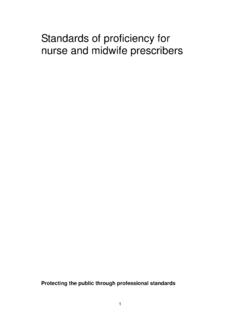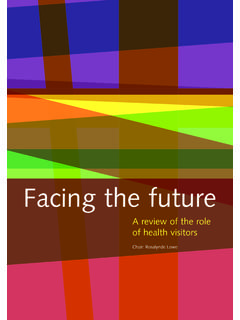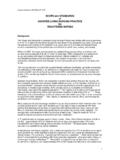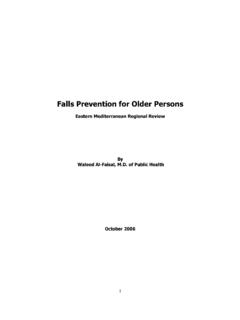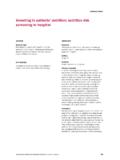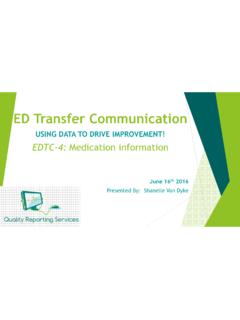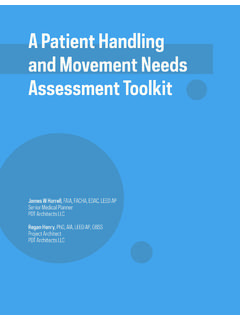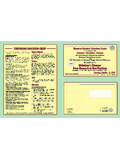Transcription of Competencies: an integrated career and …
1 Competencies: an integrated career and competency framework for information sharing in nursing practiceRCN Com p e te nc ie sRCN Com p e te nc ie sContributorsThe competency framework was developed by MarinaCopping, Clinical information Manager, NHS Lothian,on behalf of the Royal College of nursing (RCN).It was reviewed by a number of external experts andRCN members and :For ease of reading, patients and/or clients arereferred to simply as patients in this L egal Disclaimer This publication contains information , advice and guidance to help members of the RCN. It is intended for use within the UK but readers areadvised that practices may vary in each country and outside the UK. The information in this booklet has been compiled from professional sources, but its accuracy is not guaranteed. Whilst every effort has beenmade to ensure the RCN provides accurate and expert information and guidance, it is impossible to predict all the circumstances in which itmay be used.
2 Accordingly, the RCN shall not be liable to any person or entity with respect to any loss or damage caused or alleged to be causeddirectly or indirectly by what is contained in or left out of this website information and by the Royal College of nursing , 20 Cavendish Square, London, W1G 0RN 2006 Royal College of nursing . All rights reserved. No part of this publication may be reproduced, stored in a retrieval system, or transmittedin any form or by any means electronic, mechanical, photocopying, recording or otherwise, without prior permission of the Publishers or alicence permitting restricted copying issued by the Copyright Licensing Agency, 90 Tottenham Court Road, London W1T 4LP. This publicationmay not be lent, resold, hired out or otherwise disposed of by ways of trade in any form of binding or cover other than that in which it ispublished, without the prior consent of the COLLEGE OF NURSING1 Competencies: an inte g rate d c are e r an d c o m p e te n c y f ram e wo r kfor information sharing in nurs ing practice1.
3 Introduction2 Purpose and scope 2 information sharing in context2 Legislation, policy and practice 32. Sources and related work43. Overview of the framework54. The RCN competency framework for information sharing in nursing practice65. References156. Other resources16 Appendix 1: Abbreviations and useful definitions17 Approved until November 2007 Contents2 RCN COMPETENCIES information SHARINGI ntroductionRecent changes in Government policy on the exchange ofhealth information coincide with ongoing plans to makepatients health records more easily accessible, usingelectronic means. Easier access to health care data from asingle source shared by everyone could improve thequality and efficiency of care services, reduce the burdenof paperwork and even save lives. Easy data access, however, also makes patients morevulnerable which highlights the importance of highprofessional practice standards through a framework forgoverning clinical information .
4 Nurses will easily relate tocore standards in this framework such as confidentiality,security and consent, but debate at a recent RCN congressshowed members concerns about nurses knowledge andskills in this complex area of practice. This document has been produced in response to theseconcerns, with the twin aims of improving the profession sunderstanding of this critical element of practice and ofsupporting action by nurses, managers, educators andothers to work towards improved competence ininformation sharing practice. Purpose and scope ofthis framework The development of the competency framework forinformation sharing in nursing practice is based on thefollowing position statement: to fulfil their professional responsibilities, nurses musthave the knowledge and skills to hold, obtain, share,use and store information about patients (informationmanagement) nurses must share information about patients withinlegal, professional and common law frameworks,placing the needs and preferences of the patient at thecentre of care nurses should be confident that patients fullyunderstand their rights and any implications ofinformation sharing , before asking a patient to consentto such sharing (and in most cases before asking themto provide sensitive information ).
5 information sharing competencies span all areas ofnursing practice and apply also to health care assistants,nurse researchers and others who may have occasion toshare information about patients. Every effort has beenmade to ensure that the RCN framework is applicableacross all four countries of the UK legislative andorganisational differences are noted where relevant. The specific purposes of this competency framework areto: aid practitioners with professional development,helping them to identify gaps in competence andspecific training needs provide a basis for assessment of information sharingcompetence inform the commissioning, development and deliveryof education and training on information managementand information sharing contribute to developments related to Agenda forChange, Skills for Health and other initiatives, byproviding a professional nursing view of this coreclinical sharing in contextFor the purpose of this framework , information sharing isdefined as: the transfer of information about anindividual verbally, in writing, electronically, as images orvideo from one person/place to another.
6 This definition applies to information about staff as well asabout patients, relatives and carers, but while theprinciples set out in the framework apply to all thesegroups, the primary focus here is on sharing is a part of information managementand is central to clinical communication, supporting theprovision of safe, effective and efficient services. It helpsensure continuity, saves time and avoids duplication. Suchbenefits, however, must be balanced against a person sright to health and social care, most information about anindividual that in any way identifies them is defined assensitive in nature by the Data Protection Act 1998(Parliament, 2000). Before sharing such information , theremust be clear understanding and agreement about who issharing what information , for what specific purpose, andover what time period. The information itself needs to be1 ROYAL COLLEGE OF NURSING3complete, accurate and not excessive for the agreedpurpose. Crucially, in most instances, sharing ofinformation should only be done with the explicit consentof the , policy and practice There is now increased focus on information andcommunications technology and on better management ofinformation in general.
7 New legislation has been enactedin the UK similar to laws already in place across Europe,Canada, Australia and New Zealand. The Data ProtectionAct 1998, Human Rights Act 2000, Freedom of InformationAct 2002 and Children Act 2004are driving changes inpractice and in organisational culture concerninginformation sharing . New ways of working prompted by recent health policiessuch as patient choice, single assessment and Eve r y ChildMatters(DfES, 2004) have introduced challenges fornursing practice as well as for organisations. Inter-agencyworking is a policy priority as is the breaking down ofbarriers between primary, community and secondaryhealth care. Person-centred care pathways are increasinglycited in service standards and frameworks as the best wayto deliver effective, equitable health care. As these changesare implemented they are further exposing the poorpractice in information sharing which was alreadyhighlighted in reports such as the Laming Inquiry (2002)into the death of Victoria Climbi in England and theKennedy Inquiry (2002) into the death of baby Caleb Nessin practice level there is greater emphasis on integratedassessments, particularly in services for children and olderpeople.
8 Alongside the development of common assessmentframeworks, protocols are being written to supportinformation sharing between professionals, often focusingon the specifics of the Data Protection Act 1998(Parliament, 2000). However, issues of information sharingin nursing go much wider than this Act. Nurses work withall patient groups including vulnerable adults, childrenand people with mental health problems; these groups arethe subject of additional legislation, knowledge of whichforms part of the competencies required for rapid spread of information and communicationstechnology throughout the UK health sector is alsobringing information sharing issues to the fore. As localservices develop their systems, the interfaces required tosupport communication between providers and locationsbecome even more obvious, as do the challenges to and related workThe RCN competency framework for information sharingin nursing practice is an extension of the RCN c orecompetency framework (RCN, 2005) and is linked to theRCN Learning Zone development on information sharing ,consent and information sharing competencies are groundedmost often in statute, policy guidance and professionalcodes of practice and these are the main sources for thisframework.
9 The framework is based on previous work onhealth information sharing , specifically the NHSI nformation Authority project Learning to ManageInform ation(NHSIA, 1999) and the NHS Knowledge andSkills framework (KSF)(DH, 2004). It expands on these bygiving more detail of specific nursing and midwiferyknowledge and practice competency requirements atdifferent career levels. Links to the competencies defined in the NHS KSF aremade explicit in the competency tables shown in thisdocument. Learning outcomes have been defined whereverpossible using the outcomes defined in the KSF. Whererelevant, references are made in the competency tables tothe appropriate level of KSF core competencies, KSFinformation and knowledge competences (IK) and KSFhealth and wellbeing competencies (HWB). Occasionalreference is made to the Learning to Manage HealthInform ation(NHSIA, 1999) document (LTM).4 RCN COMPETENCIES information SHARING2 Overview of theframeworkLike other RCN competency frameworks, this one reflectsthe belief that cognitive, psychomotor and affectiveattributes define clinical competence for holistic nursingpractice.
10 The framework has four levels ( competency ) andfourteen domains (activity areas). Levels of competenceLevels of competence defined in the framework reflect thecareer structure for nursing defined in Making adifference: strengthening the nursing and midwifery andhealth visiting contribution to health and health care(DH,1999) and are cumulative higher levels of practice buildon earlier competence. Empty cells in the tables indicateno higher (or lower) competency 1:Health care support workersHealth care assistants (and other nursing support roles)are central to direct patient care. As the KSF makes clear,all members of the health care team must have corecompetencies in communication. Safe, effectivemanagement of information is also a base competency forstaff. Level 2:Registered practitioner/competent nurseThe competencies specified at this level are the minimumrequired of all nurses and midwives on the nursing andMidwifery Council (NMC) register. These competenciesare transferable to any setting and are required in all areasof general and specialist 3:Senior registeredpractitioner/experienced nurseLevel 4:Nurse consultant Domains communication and informationexchange with children, patients, meaning for arrangements between differentprofessionals in a team and in related patient information with confidentiality,respecting the right to dignity, privacy andintegrity.

